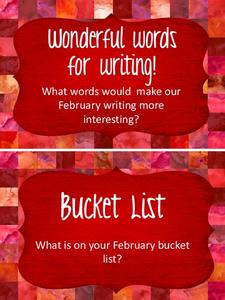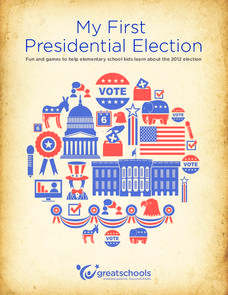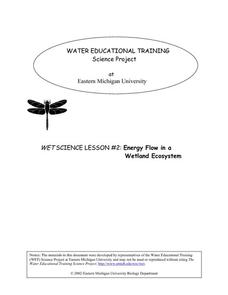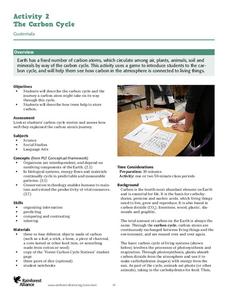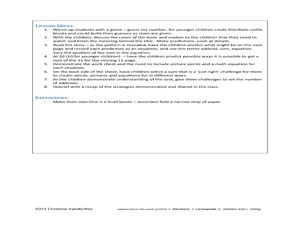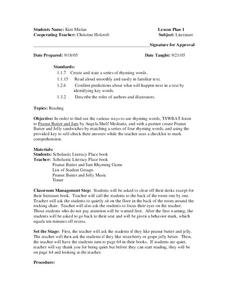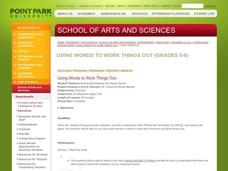Curriculum Corner
February Bell Ringers
Use a set of 30 writing bell ringers to get through the month of February. Writers tap into and write about how February makes them feel, what it smells like, and all types of celebrations that occur during the month.
Curated OER
Storytime
By reading two books aloud, Ben and Becky in the Haunted House and The Ghost in the Classroom, youngsters learn new words and understand story events. They workin small groups to review the vocabulary in a game-like setting.
Great Schools
My First Presidential Election
Register, establish a platform, make campaign speeches, and design campaign advertisements with a study of presidential elections. Young citizens engage in various activities that mimic the election process.
PBS
Blue Ribbon Readers: Drawing Inferences
Model for young readers how to use illustrations, chapter titles, and events in a story to draw inferences and make predictions. Learners then practice these essential comprehension strategies by drawing inferences for another section of...
Curated OER
If You Give A Mouse A Cookie: A Lesson In Economics
Students explore the concept of cause and effect as it relates to economics through the story "If You Give A Mouse A Cookie." Students discuss simple cause and effect relationships and make predictions according to the story. They play...
Curated OER
Pollution in the Air and the Water Pollution Solution
Students explore air pollution. In this ecology and air pollution instructional activity, students perform an experiment in which a Vaseline coated lid is placed inside and outside the classroom. Students make predictions and then record...
Curated OER
Spicy Hot Colors
First graders discover the importance of primary colors by reading a book in class. In this art lesson, 1st graders read the book Spicy Hot Colors, and discuss the three primary colors and the numerous combinations they can make....
Western Illinois University
Activities for Supporting Oral Language Development
Support young scholars' oral language development with the use of four early childhood activities. To reinforce proficiency, pupils read with an adult, play a game of telephone with their peers, put on a play with puppets or stuffed...
Curated OER
Antonyms, synonyms and homophones
Shed light on what antonyms, synonyms, and homophones are. For this lesson, upper elementary schoolers create pairs using an antonym, a homophone, and/or a synonym. Then they play an antonym matching game.
Curated OER
Can you Top That?
Students make connections between their own experiences and the story, "get" the author's message and be able to discuss it with other readers, and apply their reading skills and strategies. They predict what happens in the story,...
Eastern Michigan University
Energy Flow in a Wetland Ecosystem
How is energy transferred within an ecosystem? What would happen to a food web if one of the organisms was removed? Elementary or middle school ecologists examine these questions and more in a comprehensive 5E learning cycle lesson....
Rainforest Alliance
The Carbon Cycle
Scholars learn about the carbon cycle, play a carbon cycle game, and then write a story based on their role as a carbon atom during the game. After the writings, pupils analyze the carbon cycle by leading a class discussion on the material.
Curated OER
Counting on Frank
Eighth graders read a book "Counting on Frank" with a partner. Using the text, they identify eight clues and use their mathematical reasoning in real-life situations. They participate in a game and turn in a notebook in which they write...
Curated OER
Book Title: One is a Snail, Ten is a Crab
Students read a story and write math problems. In this reading and math comprehension lesson, students preview and read the book "One is a Snail, Ten is a Crab". Students predict ways to get a sum of 11, write math equations and draw...
Curated OER
Shaping Up!
Kindergartners are introduced to basic shapes. Learners spend 45 minutes a day in geometry centers carrying out the activities outlined in this ambitious plan. There are games, hands-on activities, interactive websites, art projects,...
Curated OER
Rhyme Time Lesson Plan
What words rhyme? Help young learners deepen their understanding of rhyming words with this interactive plan. First they identify some words that rhyme, then they participate in a picture walk. Use books with rhyme, like Come Rhyme with...
Harper Collins
If You Give...Series Teaching Guide
If you give teachers a few good ideas, they can really bring a story to life. Included in this resource are dozens of activities to use as your class reads books in the If You Give... series. From holding puppet shows and creating comic...
Utah Education Network (UEN)
Simplifying Algebraic Expressions
Sixth and seventh graders explore the concept of simplifying algebraic expressions. They review the order of operations and apply properties to simplify and compare them. The author suggests using a "Boxes Game" as a motivator to get...
Curated OER
Spring Lesson Unit on Peter Rabbit by Beatrix Potter
Students read about Peter Rabbit. In this lesson, about reading and comprehension, students listen to the story, The Tale of Peter Rabbit, by Beatrix Potter. Students answer questions about the story to determine comprehension. Students...
Curated OER
No Title
Learners listen to rhyming words from the story "Peanut Butter and Jam" by Angela Shelf Medearis and create their own peanut butter and jelly sandwiches with a partner. They match a series of four rhyming words with a key that's provided...
Curated OER
Making Cultural Connections
Students explore cultures through storytelling. They read African folktales. Students discuss characteristics of folktales. They research and write a folktale that includes an animal. Additional cross curriculum activities are included.
Curated OER
Waterdrops
In this science learning exercise, students learn about water cycle, weather, clouds, storms and water resources by completing 8 pages of this full color newsletter. Students read a story, study weather maps, learn to make a rain gauge,...
Curated OER
Using Words to Work Things Out
Students explore classroom community building. In this character development and community building instructional activity, students listen to Hands Are Not for Hitting and generate a class list of positive ways to handle classroom...
Curated OER
Why Walk?
Following the story Yummers, pupils will use the food pyramid to evaluate what Emily Pig ate during her walk and find out why her walk made her sick. They will then participate in a walking game.


